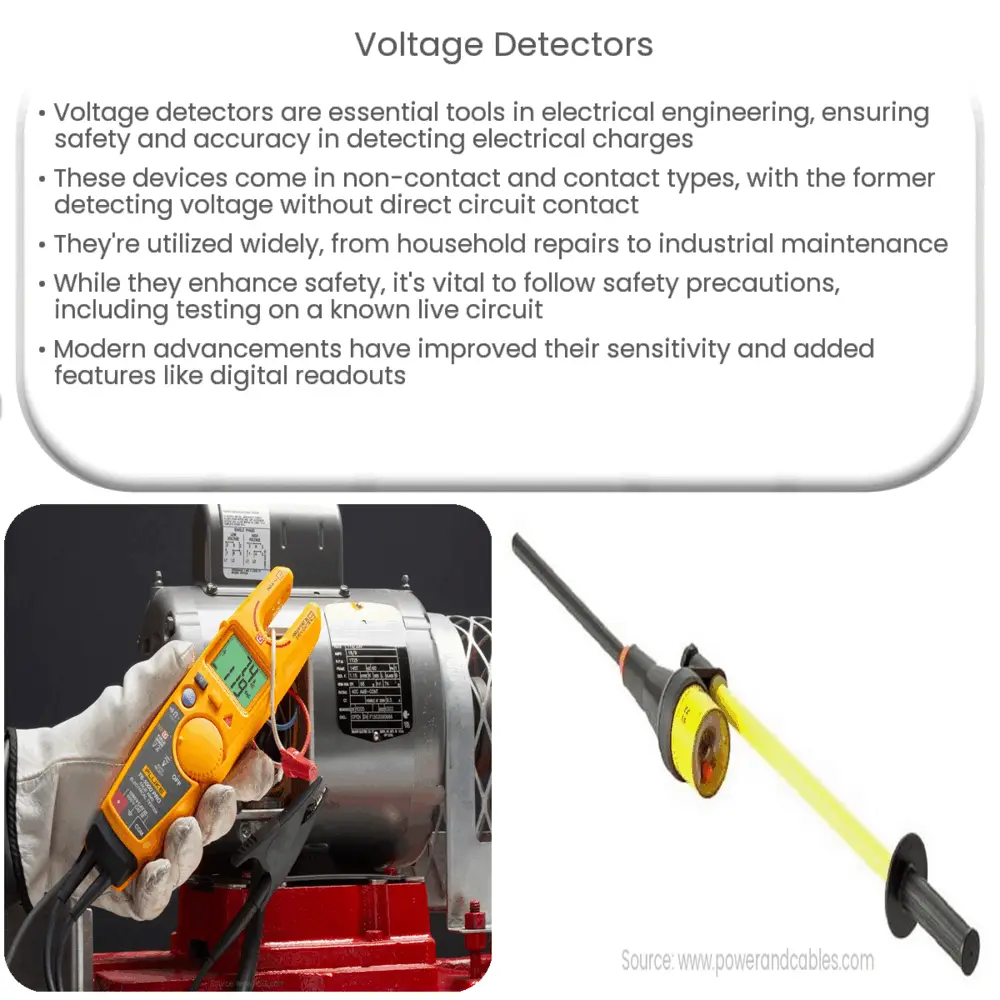Voltage detectors are generally safe when used correctly and according to manufacturer guidelines. They serve as an essential tool for electricians to check for live wires without direct contact.
Voltage detectors are invaluable in ensuring safety during electrical work, offering a non-contact way to identify live circuits before any work begins. These devices can prevent electric shocks, thus they are a staple in any professional’s toolkit. With proper maintenance and care, voltage detectors contribute to a safer work environment by helping to avoid the dangers of unexpected electrical currents.
It’s crucial for users to understand their voltage detector’s specific features, limitations, and instructions to maximize safety benefits. As this technology continues to advance, the reliability and safety of voltage detectors are likely to increase, giving users peace of mind while handling electrical tasks.

Credit: www.electricity-magnetism.org
The Basics Of Voltage Detectors
Understanding voltage detectors is key to electrical safety. They quickly tell us about live wires without touching them. They are small, handheld tools used by electricians and DIY enthusiasts alike.
What Voltage Detectors Do
Voltage detectors sense electrical charges nearby. Their main job is to prevent electric shocks. When you bring them close to a wire, they beep or light up if there’s voltage. This way, they keep users safe from potential hazards.
Types Of Voltage Detectors
There are several voltage detectors to choose from:
- Non-contact voltage testers: These beep or glow near live circuits. They don’t need to touch the surface directly.
- Pen testers: Shaped like pens, they’re indeed portable. You can clip them onto a shirt pocket.
- Outlet testers: These go into outlets to check if they are wired correctly and show live voltage.

Credit: www.amazon.com
Electrical Hazards And Prevention
Understanding electrical hazards and prevention is key to safety at home and work. Voltage detectors can help identify potential dangers. Yet, are they foolproof? Knowing common risks and how to prevent them is the first line of defense.
Common Electrical Risks
- Exposed wires: A shock risk that can cause burns or other injuries.
- Overloaded circuits: They may lead to fires when too many plugs share one outlet.
- Water and electricity: A deadly mix that should always be avoided.
- Old or damaged appliances: They can malfunction and become dangerous.
Preventative Measures
To minimize electrical risks, follow these steps:
| Action | Purpose |
|---|---|
| Regular inspections | Spot hazards early |
| Using voltage detectors | Check for live wires |
| Keeping appliances away from water | Prevent shocks |
| Maintaining electrical systems | Ensure everything works safely |
Child-proof outlets, GFCI installations, and avoiding DIY electrical work are also vital. Always turn off the power before attempting any electrical task. Use professional help for complex problems.
Safety Features Of Voltage Detectors
Voltage detectors are vital tools for electricians and DIY enthusiasts alike. They provide a non-contact means to test for electrical currents in wires, sockets, and devices. Understanding the safety features built into these detectors is crucial to ensure user protection during their use. These features are skillfully designed to prevent accidents and give reliable readings every time.
Built-in Safety Mechanisms
Voltage detectors come with several built-in safety features. These features help ensure the safety of the user.
- Insulated Housing: Provides a protective barrier.
- Tip Sensitivity: Detects voltage without direct contact.
- Audio and Visual Indicators: Alert promptly to voltage presence.
- Self-Testing Ability: Verifies operational status before use.
Standards And Certifications
Certifications confirm a voltage detector’s safety and reliability. Reputable standards must be met.
| Certification | Description |
|---|---|
| CE | Compliance with EU safety directives. |
| UL | Approval from Underwriters Laboratories. |
| ETL | Testing to North American safety standards. |
| IEC | International Electrotechnical Commission standards met. |
Proper Usage Of Voltage Detectors
Voltage detectors are handy tools in ensuring electrical safety. These devices help confirm the presence or absence of electricity in wires, outlets, and other electrical components. It is essential to use them correctly to avoid accidents and injuries.
Do’s And Don’ts
- Do always test the voltage detector on a known live circuit first to ensure it’s working.
- Do confirm that the batteries in your detector are fresh for reliable performance.
- Don’t use a voltage detector near water or in wet conditions.
- Don’t forget to read the manufacturer’s instructions before use.
Training For Safe Operation
To guarantee safety when using voltage detectors, proper training is crucial. Only trained individuals should operate these devices. They need to know the following:
- The device’s operating instructions.
- How to interpret the signals from the detector.
- What to do if a live circuit is detected.
Training should also include hands-on practice in a safe, controlled environment.
Testing And Maintenance
Electricity is a powerful force that demands respect and caution. To handle it safely, a voltage detector is your best friend. But like any tool, it needs to be in tip-top shape to protect you. Let’s dive into the details of keeping your voltage detector ready and reliable through proper testing and maintenance.
Routine Device ChecksRoutine Device Checks
A regular check-up is vital to keep your voltage detector performing its best.
- Test the detector every day before use.
- Ensure the battery is strong enough for accurate readings.
- Clean the device to avoid false readings from dirt buildup.
- Check for physical damage like cracks or broken parts.
- Use a known live source to confirm the detector’s response.
Repair Or Replace Criteria
Knowing when to repair or replace is key to safety.
| Issue | Action |
|---|---|
| Weak Battery | Replace Battery |
| No Response to Live Source | Replace Device |
| Physical Damage | Replace Device |
| Inconsistent Readings | Service or Replace |
Technology Advancements In Voltage Detection
Electricians and DIY enthusiasts alike rely on voltage detectors for safety. These devices alert users to the presence of electrical current. Advancements in technology have made voltage detectors more reliable and easier to use.
Innovative Designs
Modern voltage detectors offer innovative features, making them more user-friendly.
- Integrated Displays: Some models have screens showing voltage levels.
- Adjustable Sensitivity: Users can set detection thresholds suited to specific tasks.
- Self-Testing Capabilities: New detectors perform self-checks to ensure functionality.
Enhanced Sensitivity And Accuracy
Accuracy is critical in voltage detectors. Technological advancements have fine-tuned this aspect.
- Microprocessor Controlled: Precision is improved with smart chip technology.
- Non-Contact Detection: Helps to avoid direct contact with live wires.
- Sound and Light Alerts: Beeps and flashes indicate voltage presence clearly.
| Feature | Old Models | New Models |
|---|---|---|
| Design | Basic with limited functionality | Ergonomic with enhanced capabilities |
| Sensitivity | Fixed | Adjustable |
| Accuracy | General indication of voltage | Precise voltage levels |
Personal Protective Equipment (PPE) And Voltage Detector Use
On the front lines of electrical safety, workers trust in the reliability of voltage detectors for their protection. But equipment alone doesn’t shield from danger. Wearing the right Personal Protective Equipment (PPE) is a crucial step. It teams up with voltage detectors to create a secure environment. This synergy is essential for minimizing risks during electrical work.
Selecting Appropriate PPE
Choosing the right PPE is a task that demands attention. It’s not about just grabbing a helmet or gloves. PPE should meet specific standards to warrant safety. Insulating gloves, flame-resistant clothing, and protective eyewear form the shield against electrical hazards.
- Rubber insulating gloves prevent electric shock.
- Face shields protect from arc flashes.
- Flame-resistant clothing saves the skin from burns.
A thorough hazard assessment shapes PPE selection. Using PPE that matches the voltage levels will secure safety.
Coordinating Ppe With Detectors
Integrating PPE with voltage detectors is vital. This coordination boosts safety. Voltage detectors signal the presence of voltage. PPE serves as the last line of defense. Ensuring they function together is key.
| Voltage Range | Recommended PPE |
|---|---|
| 0-600V | Insulating gloves, safety glasses |
| 600-1000V | Insulating gloves, arc-rated clothing |
| 1000V+ | Insulating gloves, arc flash suit |
Regular testing of PPE and detectors is non-negotiable. They have to be in top condition and complement each other for maximum safety.

Credit: www.amazon.com
Case Studies: Voltage Detector Safety
When it comes to working with electricity, safety is paramount. We often rely on tools to help us determine the presence of live voltage. Voltage detectors are handy in such scenarios, but are they always safe to use? This section explores real-life case studies that shed light on the effectiveness and safety of voltage detectors.
Incidents And Lessons Learned
Voltage detectors are designed to enhance electrical safety. However, incidents occur that can teach valuable lessons. Let’s delve into some notable cases and extract crucial insights.
- Case Study 1: An electrician reported a false negative from a non-contact voltage tester.
- This led to a minor shock incident, reminding users to test their detectors on known live circuits before use.
- Case Study 2: A voltage detector failed to indicate live wires due to weak batteries.
- The takeaway is clear: regularly check and replace batteries to ensure functionality.
Best Practices Illustrated
Through these studies, we identify best practices to maximize safety with voltage detectors.
| Best Practice | Details |
|---|---|
| Verify Detector Operation | Always test your voltage detector on a known live circuit before actual use. |
| Regular Checks | Inspect your detector for damages and ensure it has fully functional batteries. |
| Proper Training | Understand the tool’s limitations and operating conditions for safe use. |
Frequently Asked Questions On Are Voltage Detectors Safe?
Are Voltage Detectors Reliable?
Voltage detectors are generally reliable for identifying live wires and electrical currents. However, their reliability can depend on the device quality, battery life, and proper usage. It’s crucial to test them regularly for accuracy and to ensure safety.
How Do Voltage Detectors Work?
Voltage detectors work by sensing the electric field around a conductor. When a voltage is present, the detector’s tip changes color or emits a sound. No-contact models detect through the device’s plastic insulation, making them safer to use.
Can Voltage Detectors Give False Readings?
Yes, voltage detectors can occasionally give false readings due to external factors like moisture, dirty sensor tips, or electromagnetic interference. Ensuring the device is clean and performing a pre-test can help reduce false positives or negatives.
What Are The Safety Features Of Voltage Detectors?
Voltage detectors often include features like insulated bodies, lights or sounds for indication, and self-testing abilities. Always verify that the detector meets relevant safety standards, such as those set by the IEC or UL, for added assurance.
Conclusion
Safety is paramount when handling electrical equipment. Voltage detectors play a crucial role in ensuring that. They offer a simple, effective means to test for live wires without direct contact. For any electrician or DIY enthusiast, they are an indispensable tool.
Always choose quality devices and use them correctly for optimal safety.


